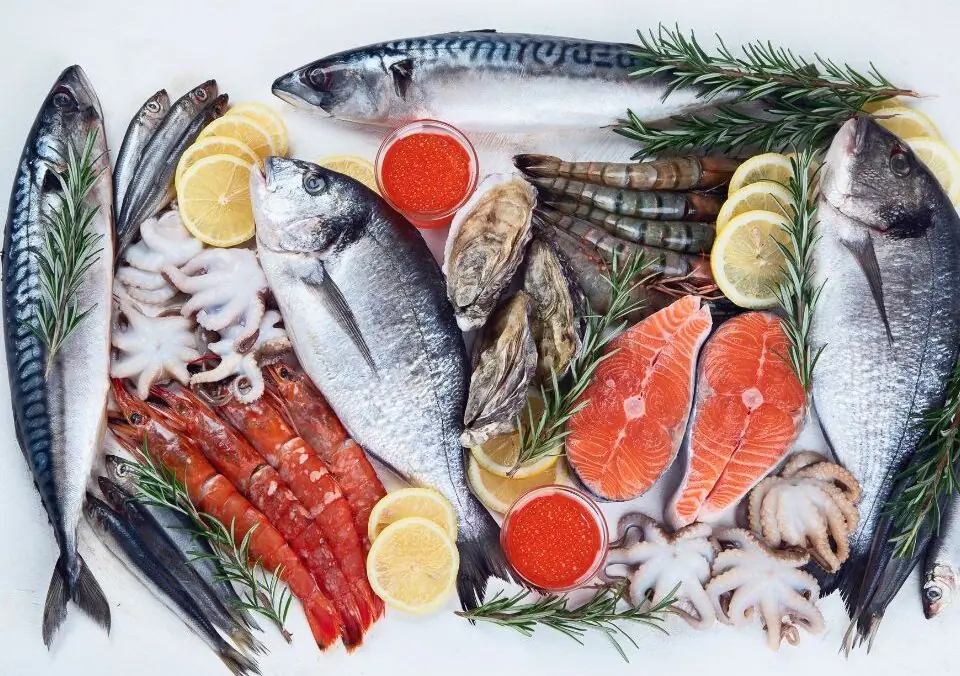Blog
Add More Fish to Your Diet!

Growing up, my absolute least favorite food in the whole world was fish. I thought fish were super cool to look at, but when it came to eating them, I thought they were stinky, had a weird texture, and a funky taste. The only kind of fish I could tolerate was popcorn shrimp completely slathered in ranch dressing, as the taste and texture were pretty well masked. However, as I’ve gotten older, my palate has broadened, and I’ve come to love eating fish, alongside all the great nutrients that it provides!
Fish is an incredible source of nutrition, and it’s something that many health experts recommend incorporating into our diets more regularly. According to registered dietitian Daphne Olivier, fish is so nutritious that we should be consuming it at least twice a week. This recommendation is not just a suggestion; it’s grounded in solid nutritional science. Both fish and shellfish are low in fat and high in protein, making them an excellent choice for those looking to maintain or lose weight while still getting enough essential nutrients.
Fish is particularly beneficial because it is rich in omega-3 fatty acids. These are a type of polyunsaturated fat that is essential for our health and cannot be produced by the body, which means we must get them from food. Omega-3s are known to have numerous health benefits, including reducing inflammation and supporting heart health. Oily fish such as salmon or tuna are among the best sources of omega-3 fatty acids. According to a study published in the journal “Circulation,” a diet rich in omega-3 fatty acids is linked with a reduced risk of heart disease and stroke.
In addition to omega-3s, fish is also packed with other vital nutrients such as vitamin D and selenium. Vitamin D plays a crucial role in bone health by helping the body absorb calcium, while selenium is essential for proper thyroid function and the maintenance of a healthy immune system. Notably, moderate consumption of fish has also been associated with reduced risk factors for chronic diseases such as diabetes and Alzheimer’s disease.

Despite my early aversions, I’ve discovered that fish can be delicious when prepared correctly, and there are countless ways to incorporate it into your meals. If you’re looking for some good fish recipes to try, here are some fantastic options from Fill Your Plate that cater to a variety of tastes and dietary preferences:
- Alaskan Salmon – This recipe highlights the rich flavor of salmon while keeping it simple to let the natural taste shine through.
- Asian Shrimp – A delightful dish that combines shrimp with fresh vegetables and a tangy sauce, making it an excellent choice for a quick weeknight dinner.
- Baked Shrimp – Perfect for those looking for an easy and healthy option, this recipe involves baking shrimp with a variety of spices to enhance the flavor.
- Citrus Scallops – The bright flavors in this scallop dish make it a refreshing choice, ideal for bringing a taste of the sea to your dinner table.
- Citrus Swordfish – Swordfish steaks marinated in citrus juice provide a hearty meal that’s both satisfying and nutritious.
- Jerry’s White Wine Glazed Trout – This flavorful preparation of trout is an excellent option for special occasions or a fancy dinner at home.
- Lemon Shrimp With Linguine – A classic pasta dish that brings the brightness of lemon together with succulent shrimp for a delightful meal.
- Shrimp and Oranges – This recipe combines the sweet and zesty flavors of oranges with shrimp, resulting in a unique and flavorful dish.
- Sole in Orange Sauce – The subtle flavors of sole paired with a delightful orange sauce create an elegant dish perfect for entertaining.
- Steamed Sea Bass on Spinach – A healthful option that features steamed sea bass served on a bed of nutrient-rich spinach.
- Tilapia – An inexpensive and versatile fish, tilapia can be seasoned in various ways to suit your flavor preferences.
Transitioning from someone who avoided fish to becoming an enthusiastic consumer has been an exciting journey. It began with exploring different types of seafood, discovering the vast world of preparations, and gradually incorporating recipes that appealed to my taste buds. There’s a wide variety of seafood available, catering to various preferences—whether you enjoy the delicate flavor of white fish or the robust taste of oily fish.
When it comes to choosing seafood, sustainability is also a consideration that many of us now embrace. Overfishing and harmful fishing methods can have lasting impacts on marine life and ecosystems, making it crucial for consumers to make informed choices. Resources such as Seafood Watch offer guidance on sustainable seafood choices, which can help you support responsible fishing practices.
To further enhance your fish dishes, consider pairing them with colorful vegetables and ample herbs or spices. The Mediterranean diet, known for its health benefits, prominently features fish and encourages the use of fresh ingredients. Incorporating Mediterranean elements such as olive oil, garlic, fresh herbs, and vibrant vegetables can elevate your fish meals and provide a well-rounded nutritional profile.
Additionally, exploring regional cuisines can open up a treasure trove of inspirations for preparing fish. For instance, in Asian culinary traditions, fish and seafood play a significant role. Dishes like sushi, sashimi, and grilled fish marinated in flavorful sauces reflect the diverse ways fish is celebrated globally. Looking to Japanese cuisine can introduce you to new methods, while traditional dishes from other cultures, such as Mediterranean and Latin American cuisines, can inspire your culinary adventures.
For a safe and enjoyable fish-eating experience, it’s essential to pay attention to how seafood is sourced and prepared. Choosing fresh fish from reputable suppliers increases the likelihood of flavor while reducing the risk of foodborne illness. If you’re unsure about the freshness of fish at your local market, consider asking questions about sourcing or looking for certifications of sustainability.
Moreover, it’s important to be aware of potential contaminants in fish, particularly larger species that can accumulate mercury, such as shark, swordfish, and king mackerel. Pregnant women, nursing mothers, and young children should be especially cautious regarding their seafood consumption. Resources like the Food and Drug Administration (FDA) provide useful information on seafood safety and recommendations.
As we strive to incorporate more fish into our diets, it’s also beneficial to consider how to blend this nutritious food with our lifestyles. Meal planning can be incredibly helpful in ensuring that fish becomes a staple in our weekly menus. By dedicating one or two nights a week to fish, you can create a habit that enriches your diet and allows for culinary experimentation.
Fish tacos, grilled fish sandwiches, and creamy fish chowders are just a few examples of how versatile fish can be in meals. For families with picky eaters, considering fish in familiar formats like burgers or tacos can help ease the transition into consuming more seafood. You can also involve family members in the cooking process, which not only adds fun to meal preparation but also helps everyone appreciate the food they are eating.
In line with current trends, embracing fish can also be aligned with environmentally conscious choices. With more individuals advocating for a plant-rich diet, including seafood can strike a balance that supports both health and sustainability. Adopting practices that promote biodiversity, such as consuming lesser-known fish varieties, can lower the pressure on overfished species and deliver nutritional benefits while exploring new flavors.
Ultimately, the goal is not just to eat fish but to enjoy it fully as part of a balanced diet that promotes health and well-being. By committing to making fish a regular feature on your table, you can reap the benefits of its nutritional profile while enjoying delicious meals that come from various culinary traditions.
For more food and health articles, and to widen your culinary horizons, check out the Fill Your Plate blog. The exploration of recipes, health tips, and diverse cultural perspectives on food can inspire a lifelong journey of enjoying fish and other nutritious foods.
The adventure of adding more fish to your diet is one that can lead to a deeper appreciation for food, sustainability, and health. It’s time to embrace the ocean’s bounty and make fish a star player in your nutrition game!
By Heide Kennedy, Arizona Farm Bureau Communications Intern


















